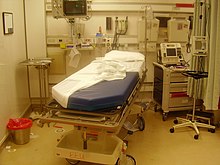emergency department


The emergency room (also emergency room , emergency room , emergency room , emergency department , emergency, emergency center or first aid station ) is a focal point in the hospital for acute care and is part of Emergency Medicine . Every hospital (exception: private clinics, rehabilitation hospitals) has an emergency room, which is usually open around the clock and where medical help is provided.
In the eastern federal states of Germany, the term “emergency room” is more widely used instead of “emergency room”. The abbreviation RTS is also used here . In the old federal states as well as in Austria the term “emergency room” (also “emergency ambulance”, “emergency aid” or “emergency room”) is used more frequently. In Switzerland, the emergency room is known as an "emergency station". Sometimes the hospitals' polyclinics also function as emergency rooms outside of working hours.
Only emergencies are treated in an emergency room . Usually there is no ordinary outpatient care there. Certificates of incapacity for work are not issued. In clinics with an accident surgery department, the treatment of occupational accidents ( D-doctor procedure ) is often spatially attached to the emergency ambulance, whereby these can also issue certificates of incapacity for work after occupational accidents.
The patients are not necessarily treated in the order in which they arrive, but rather according to urgency. The correct assessment of the patient ( triage ) is therefore a very important measure in the emergency room. For this purpose, the vital parameters ( blood pressure , pulse , respiratory rate ) and often additional values such as oxygen saturation or heart rate are measured for each patient or existing measurement data and information from the rescue service personnel are taken into account. The urgency of the treatment can then be assessed by the nursing staff using flow charts and checklists (e.g. Manchester triage system ).
Some emergency rooms also have their own bed ward (called “admission ward” in many clinics), in which long-term treatments are carried out and patients who are medically necessary to be admitted to hospital wait for a free bed.
In any case, after a patient has stabilized, the doctors in the emergency department must decide whether it is necessary to keep a patient in the hospital or to discharge him from the emergency department. If necessary, there is also the possibility of temporarily placing the patient in a day clinic for further observation (for example in some cases of hypoglycaemia ). Until a few years ago, when a patient is discharged, hospital staff would often request an ambulance so that it could be brought home safely. In the meantime, journeys home are only paid for if there is a medical indication to do so. The attending physician must indicate this on the transport certificate ("TN").
In emergency rooms, doctors from various fields (e.g. anesthetists, surgeons, internists) usually work on the patient alone or in cooperation with colleagues (interdisciplinary emergency room, also central emergency room for short ZNA ). The advantage of a ZNA is that patients only need to know one point of contact and doctors from all disciplines can quickly be called in for consultations. In Anglo-American countries, the medical work in emergency rooms (is ER ) an independent field of study ( "emergency medicine").
In addition to the interdisciplinary emergency rooms, in which diseases from all medical disciplines are treated, there are also specialist emergency rooms that only accept accident surgical (e.g. broken bones) or internal (e.g. blood poisoning ) emergencies. One possible advantage of specialist emergency rooms is the distribution of the number of patients across different rooms and the associated better clarity, a lower noise level and a lower risk of mutual contamination.
Nowadays, special emergency rooms also include trauma centers . They are staffed and equipped ( shock room ) for the seriously injured . The chances of survival and the success of treatment in a specialized trauma center are to be regarded as significantly higher than in conventional surgical emergency rooms.
With the so-called stroke units, there is another relevant facility in many emergency rooms that is geared towards the treatment of stroke patients. Chest pain units are also found in an increasing number of emergency rooms, in which patients with acute coronary syndrome are diagnosed and treated by cardiologists.
See also
- Emergency practice for not immediately life-threatening cases
- Medical emergency service , also called on- call service
literature
- Wilfried von Eiff ; Christoph Dodt ; Matthias Brachmann ; Christopher Niehues and Thomas Fleischmann (eds.): Management of the emergency room, Kohlhammer Verlag , Berlin 2011 ISBN 978-3170215412
- Kevin Mackway-Jones , Janet Marsden , Jill Windle (eds.): First assessment in the emergency room - The Manchester Triage System - Verlag Hans Huber , Bern 2006, (German edition: Eds. Jörg Krey and Heinzpeter Moecke ) ISBN 978-3 -456-84317-9
- Barbara Walter , Thomas Fleischmann: Interdisciplinary emergency room - tasks, structure, future, in: Das Krankenhaus 7-2007, pp. 657–660 ( Kohlhammer Verlag )
- Rupert Sobotta : The interdisciplinary emergency room - consensus of the German society interdisciplinary emergency room e. V., in: Rescue Service 8-2007, Volume 30, pp. 806–810 (Stumpf + Kossendey Verlag)
- Thomas Fleischmann: The German way to become a specialist in emergency medicine, in: Rescue Service 8-2007, 30th year, pp. 828–831 ( Stumpf + Kossendey Verlag )
Web links
- German Society for Interdisciplinary Emergency Services V. - official website

